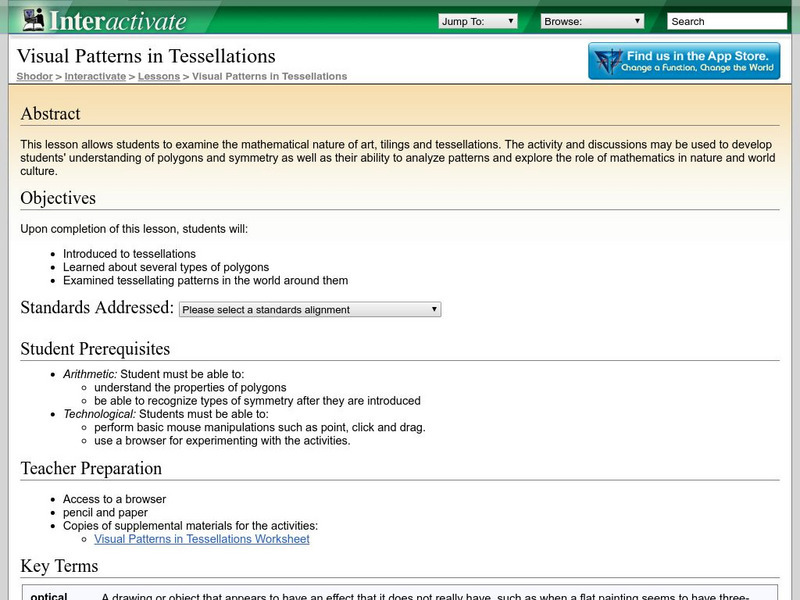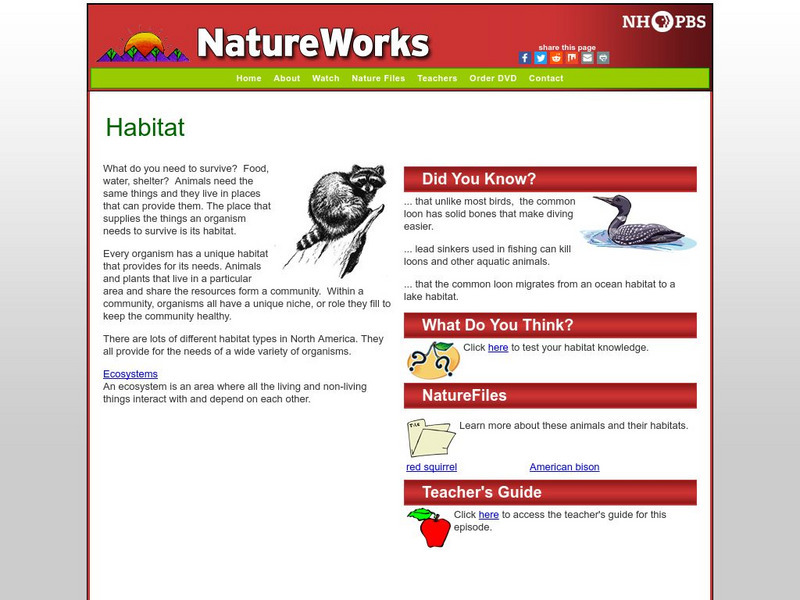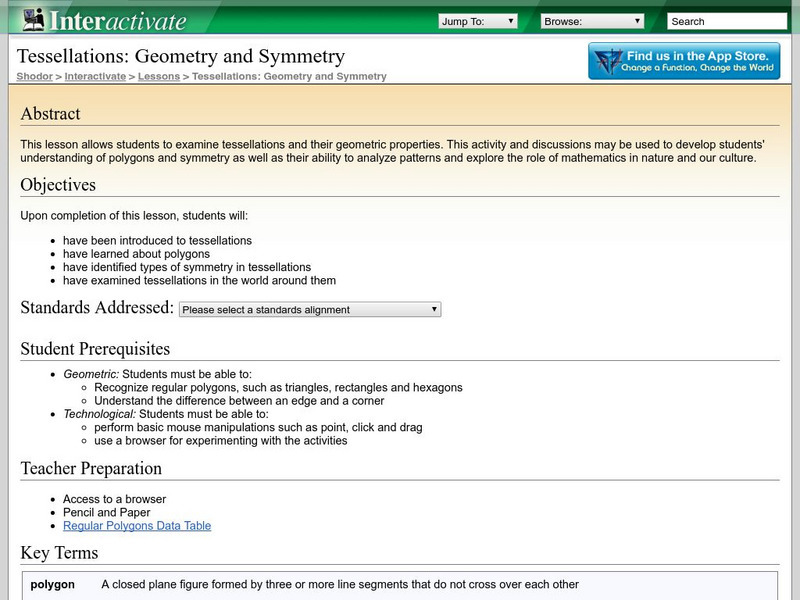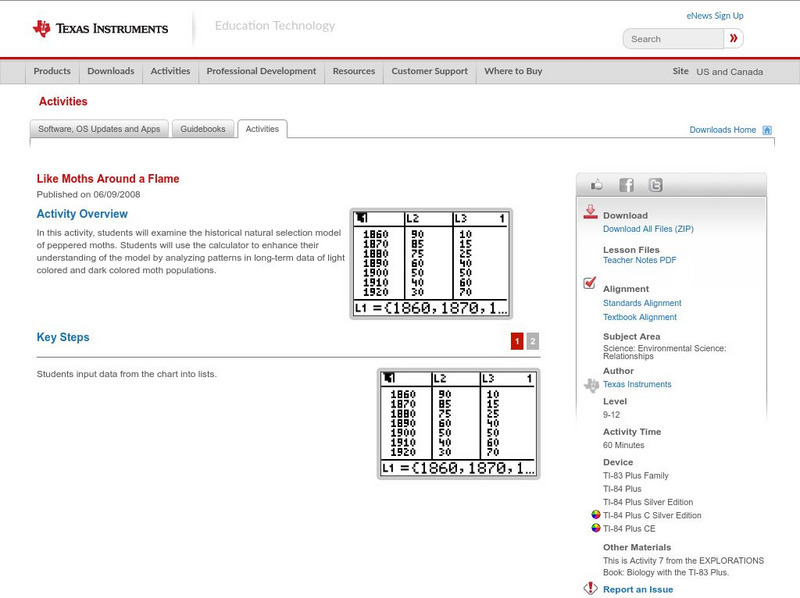Better Lesson
Better Lesson: Patterns in Nature
Are there patterns in nature that can be described by numbers? That is what we will find out here.
PBS
Pbs Learning Media: Patterns in Nature
In this video segment [3:25] from Cyberchase, a plant expert shows Bianca the patterns and symmetry found in nature.
Other
Bedford Bytes: Mother Nature
This is a selection of three image galleries to be used in conjunction with drawing classes that study patterns in nature.
Other
The Actuarial Foundation: Math Academy: Can You See It in Nature? [Pdf]
Students will build, extend, describe, predict, graph and generate rules for patterns and functions designed to help students understand the connection between geometric and numerical patterns (younger students) as well as between...
Discovery Education
Discovery Education: Numbers in Nature
This Fibonacci sequence lesson plan is aimed at grades 9-12, but would be appropriate for some junior high classes. It includes historical background and examples of Fibonacci numbers in nature, as well as suggested readings and ties to...
ClassFlow
Class Flow: Patterns in Nature
[Free Registration/Login Required] This flipchart shows some of Sir Robert Hitcham's amazing collection of photographs that are on his website. It will stimulate discussion about art in nature.
Math Is Fun
Math Is Fun: Nature, the Golden Ratio, and Fibonacci, Too
Looks at how spirals form in nature when cells reproduce in a flower, for example. An interactive lets students try entering different values to see if they can make a spiral pattern with no gaps. The correct figure would be the Golden...
Better Lesson
Better Lesson: Math With Maples
Patterns in division and multiplication can be found in nature, and an understanding of these patterns enables scientists to conduct systematic research.
Shodor Education Foundation
Shodor Interactivate: Lesson: Visual Patterns in Tessellations
This upper elementary and middle school lesson plan examines the mathematical nature of art, tilings and tessellations. Students will also explore polygons, symmetry, analyze patterns and explore the role of mathematics in nature and our...
Texas Education Agency
Texas Gateway: Chapter 7: What Causes Changes in Unemployment Over the Long Run
By the end of this section, you will be able to do the following: Explain frictional and structural unemployment; Assess relationships between the natural rate of employment and potential real Gross Domestic Product (GDP), productivity,...
PBS
Nh Pbs: Nature Works: Estuaries
Learn more about estuaries when you visit this informative site. This resource provides locations of and weblinks to estuaries in the United States.
University of Florida
Florida Museum of Natural History: Tiger Shark
The Florida Museum of Natural History presents an in-depth look at the tiger shark, named for its distinctive color pattern. Learn about the taxonomy, common names, geographical distribution, conservation, habitat, food habits,...
PBS
Nh Pbs: Nature Works: Habitat
What do you need to survive? Food, water, shelter? Animals need the same things and they live in places that can provide them. This informative site looks at the characteristics, range, habitat, food, reproduction and behavior of the red...
PBS
Nh Pbs: Nature Works: Marine Communities
This informative Natureworks site examines how life in marine communities must be adapted to live and survive under a wide variety of conditions.
Other
The Math Learning Center: Pattern Shapes
Students use pattern shapes to explore geometry and fractions, creating their own designs, or filling in outlines. As they work with the shapes students explore geometric relationships, think about angles, investigate symmetry, and...
Climate Literacy
Clean: Time Series: Uncovering the Hidden Processes in Science
In the following exercise, students will review techniques useful to scientists asthey analyze series of data. Learn about scientific observation and try to recognize a pattern or trend within the data.
Science Education Resource Center at Carleton College
Serc: Cube Puzzle and Toilet Paper Roll Model in Teaching the Nature of Science
This lesson incorporates inexpensive materials such as carton boxes, toilet paper roll tube, strings and toothpicks. It engages young scholars to conduct pattern observation, prediction, testing and ends up with a model construction. It...
Harvard University
Harvard Smithsonian: Everyday Classroom Tools
The focus of this series of lessons is to engage students in an exploration of the world around them. The emphasis is on inquiry as students learn about the earth, sun, light, shapes and more.
Houghton Mifflin Harcourt
Houghton Mifflin Harcourt: Saxon Activity Center Real World Investigation: Symmetry Around Us [Pdf]
Use this internet lesson to explore different types of symmetry in nature. Learners examine line symmetry, rotational symmetry, and bilateral symmetry. An integrated math, language art, and art lesson. Acrobat Reader required.
Nature Conservancy
The Nature Conservancy: Gardens Activity Guide: Habitats
In this lesson learners learn how the garden provides habitat for a variety of different animal species. They make observations and collect data to determine which species inhabit the garden. They will investigate relationships among...
Shodor Education Foundation
Shodor Interactivate: Lesson: Tessellations Geometry and Symmetry
This lesson plan deals with tessellations and their geometric concepts. Upper elementary and middle school young scholars will also explore polygons, symmetry, analyze patterns and explore the role of mathematics in nature and culture.
Mathigon
Mathigon: Geometry: Polygons and Polyhedra: Tessellations
This lesson focuses on tessellations, a tessellation is a geometric pattern that covers a surface without gaps or overlaps. They can be seen everywhere in nature such as a honeycomb or a tortoise shell.
Canadian Museum of Nature
Canadian Museum of Nature: Common Loon
The Common Loon is the provincial bird of Ontario. Described are it's characteristics, offspring, and migratory patterns. Ten beautiful images capture this majestic bird in its environment.
Texas Instruments
Texas Instruments: Like Moths Around a Flame
In this activity, students will examine the historical natural selection model of peppered moths. Students can use the calculator to enhance their understanding of the model by analyzing patterns in long-term data of light colored and...
Other popular searches
- Art Patterns in Nature
- Growing Patterns in Nature
- Science Patterns in Nature
- Patterns in Nature Fibonacci
- Changing Patterns in Nature
- Number Patterns in Nature
- Patterns in Nature Seeds
- Nature's Patterns in Math

















